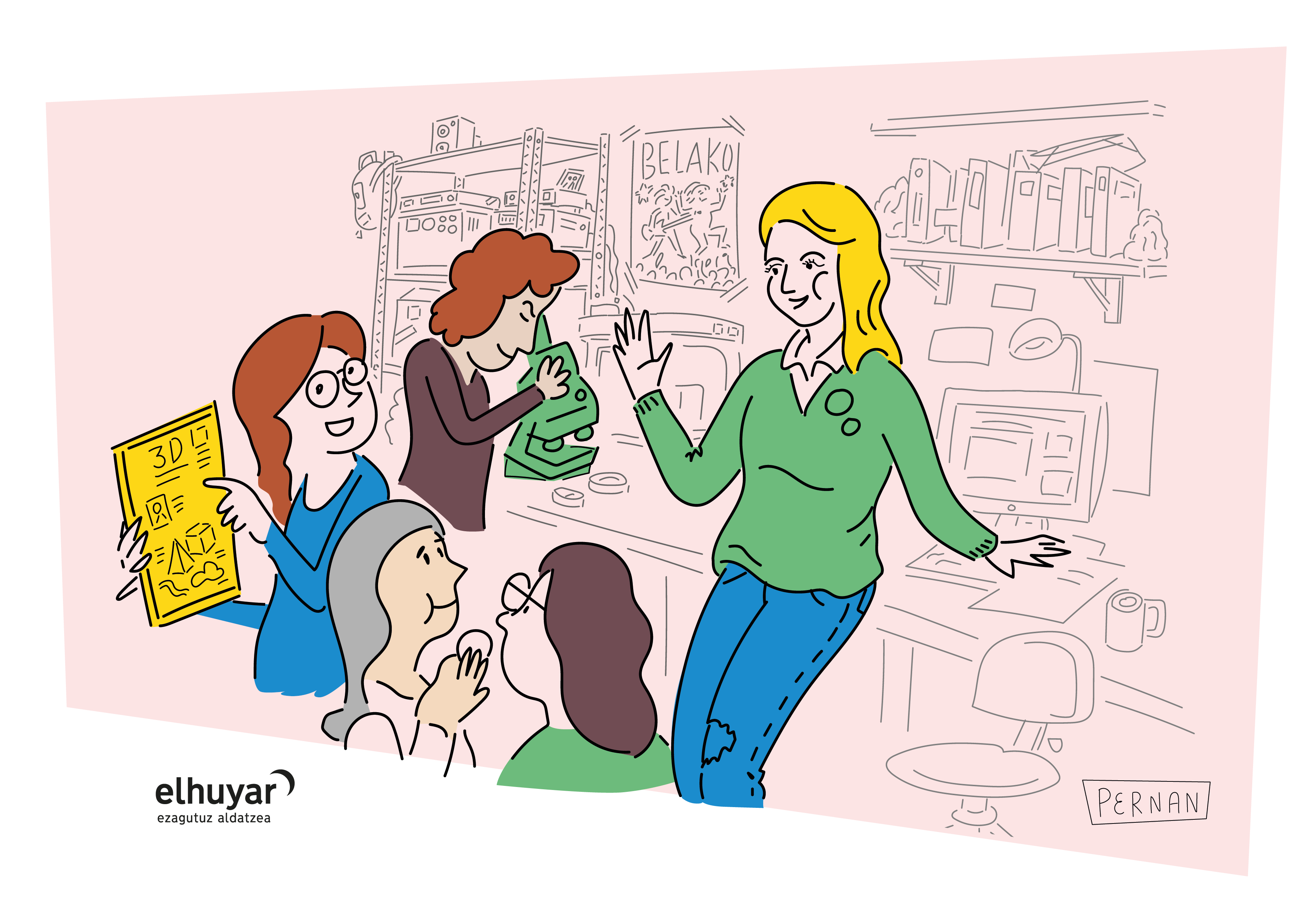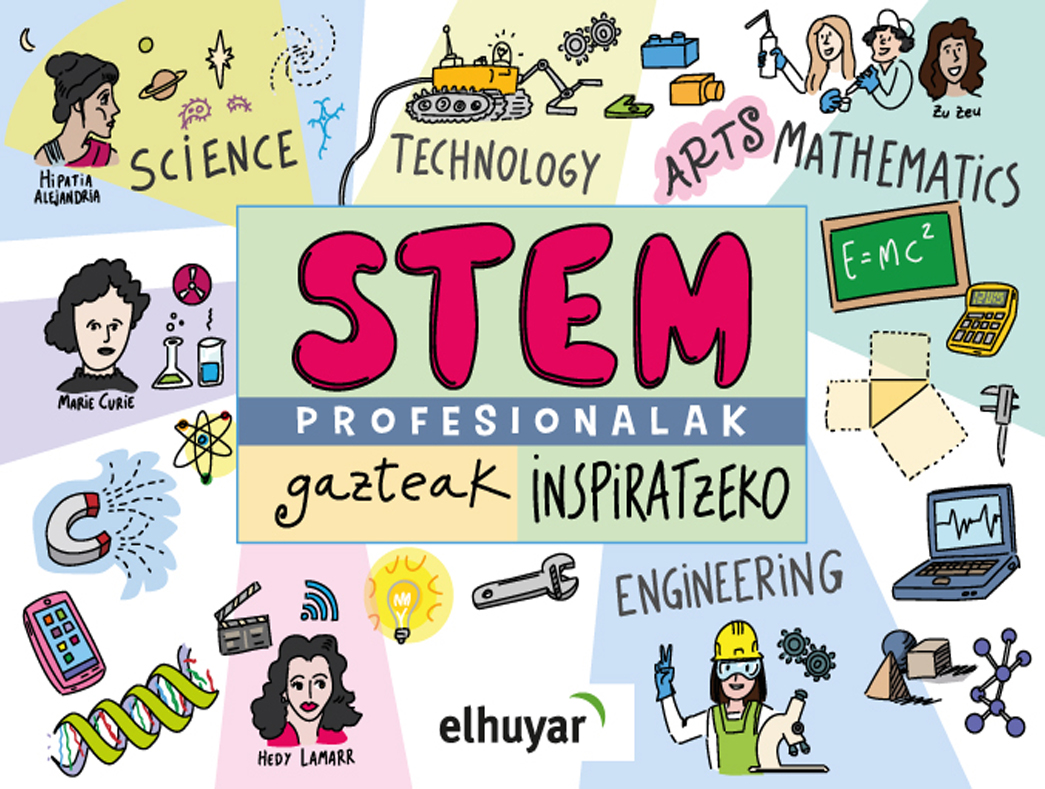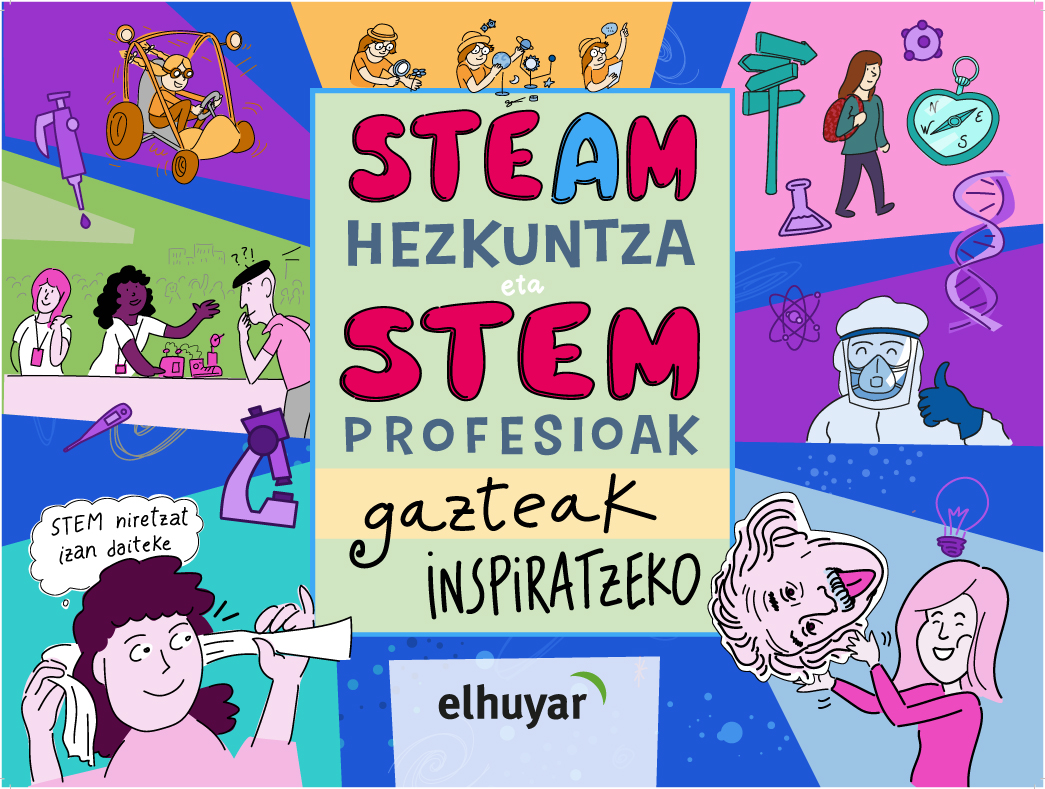Experiences and Community, Keys to Education STEAM
2021/05/06 Lasa Iglesias, Aitziber - STEAM Hezkuntza arloko arduraduna

We need STEM capabilities to promote a sustainable world and the responsibility and critical capacity of citizens to face the great challenges we face as a society, and for this we need STEM professionals. STEM is taking a leading role in both reasoning and finding solutions. However, given the data of students enrolling in universities and Vocational Training, there does not seem to be enough youth studying science, technology, engineering and mathematics (STEM), which is a cause for concern. It is also worrying that the profile of STEM students is so homogeneous: women, the working class and minority ethnic groups have few representatives.
In this context, in recent decades the concept of STEAM education has been developed, in which science, technology, engineering and mathematics are worked in interdisciplinarity. The letter A, of "art", has been used to refer to art, creativity, humanities, etc., has adopted different meanings and, at present, represents an integrating vision of all of them.
STEAM education uses the necessary methodologies to respond to the challenges of each moment, so it is constantly developing. On the one hand, it must contribute to the development of the necessary capacities to face the current and future challenges autonomously. On the other hand, it should put students at the center of the center and encourage collaboration, since it proposes working with projects so that those who learn know what it is for, applying what worked theoretically in the daily challenges.
From the point of view of gender equality, it should use methodologies that encourage the participation of girls in the STEM framework, taking as an example women professionals in science and technology, among others.
Factors influencing youth STEM positioning
Most boys and girls aged 6 to 9 say they are learning very interesting things in science schools. Students positively value the contribution of scientists to the improvement of the world and parents believe it is important to learn science. However, after wondering if they intend to work on STEM, most young people aged 10 to 14 are completely suspicious. What happens? Why do they have that attitude in puberty? And what can be done to change it? In girls the situation is even more evident. Can we do something?
For many years, in the field of scientific outreach aimed at young people, one of the objectives has been to “encourage scientific vocations” and activities have been organized to arouse interest in science and even have fun. Increased interest in science was thought to increase STEM professions. But it has not been so. ASPIRES studies conducted in the UK have shown that increased interest does not in itself imply the incorporation of scientific vocations.
Several studies have highlighted the importance of family, social, economic, personal spheres... beyond the school environment, and their influence on young people and their self-perception, as well as their future vocations.
Thus arises the concept of “STEM positioning”, which is related to interests, intentions, identity, capacity and self-confidence. The school plays a key role in STEM positioning after society and the family. The STEM environment needs the school to positively value students who are keen on science. To do this, it is necessary to lead, promote, encourage, propose experiments, organize visits to laboratories, bring scientists or STEM personnel so that young women can tell their experiences and approach this exciting world.
Stereotypes
Stereotypes about professionals working in the field of science and technology influence the choice of studies by young people. In fact, according to some studies, STEM professionals are considered by youth as exceptional talented people (brainy), which can lead to the exclusion of studies in these areas if they do not feel capable (Source: Young people´s science an career aspirations, age 10-14. King´s College London).
Deciphering the code: the education of girls and women in science, technology, engineering and mathematics (STEM) (2019), explains UNESCO that the stereotyped roles of STEM professions have a great influence on girls. Thus, according to the speakers, the tendency to self-choose is the main reason why girls stop choosing STEM education. This significantly affects the process of socializing gender roles and stereotyped ideas, such as stereotypes associated with gender and STEM.
Inequality and, above all, gender differences around STEM are evident, even in young children. Girls choose less STEM studies than boys, although a high percentage of girls say that the preferred subject is science (more than boys). Girls are much more likely to choose studies related to art and humanities. The stereotyped image of professional STEM alienates young people who do not identify with it. Another aspect that the studies highlight is: Girls abandon STEM issues as they approach adolescence. There is a conflict between STEM identity and the female identity of girls and models and referents play an important role.
In the case of minority ethnic students, there are even more factors that hinder the desire for science, since they face very diverse differences, and the difficulty to study in the field of STEM is accentuated if personal and social factors are combined (for example, racialized women).
Improved STEM positioning
To bridge the gap between STEM and youth, especially among girls, it is necessary to work from Early Childhood Education the STEM attitude for all students, not just for those who have to choose STEM studies.
Elhuyar wants to promote STEAM experiences and experiences for young people, since the factors that really influence STEM positioning are: the people we know, the family environment, successful experiences in the practice of STEM, leisure habits and studies carried out by members of the closest family, in short, the so-called “scientific capital”.
Elhuyar, as a media and outreach agent in the Basque scientific system, has been working on this line for many years, involving our nearby community. It is interesting to offer a vision of reality, the local and the nearby and to show who the protagonists are.
Being competent means having successful experiences in the classroom and being accepted for it; being real positive referents; knowing the STEM context of the professional family; testing laboratories and encouraging students' participation in knowledge building: for example, working in a laboratory or workshop; participating in fairs; fostering classroom skills; creative work; critical thinking; listening to professionals; reviewing messages given in the classroom to overcome individual effort clichés; giving value to the success of the classroom.
Studies show that the references of women in the field of STEM can be very positive in the educational process of girls. That is why the meetings between students and workers in the STEM area are increasingly numerous so that students can measure the affinity of their characteristics (professional and personal) and those of the STEM professional.
Building STEM identity is critical. Young people, and especially young people, need positive references: to make visible the contributions of women, people of different ethnicities, of different cultures, of different socioeconomic levels, not only professional successes, but also vital successes. We need referents for girls to be reflected in them and think: “STEM may be for me.”
Encounters with STEM professionals to inspire young people
The experience gained in STEAM education activities and the collaboration of various Basque institutions have made it possible for Elhuyar to have a positive influence on the future opportunities of young people aged 10 to 19. Therefore, the publication “Professional STEM for the inspiration of young people” proposes different types of meetings. This same guide, the result of a group reflection, contains a series of recommendations and examples for teachers and STEM professionals. Among the proposals are:
Laboratory reviews: Students participating in Zientzia Azoka carry out such an activity during the development of their scientific project. Each group of young people who are developing the project is visited by a STEM professional who helps them in their laboratory or workplace. The team receives methodological advice for their project, allowing them to acquire a more real dimension. In addition, and above all, students have the opportunity to know the laboratory or professional environment and the professionals who work in it.
These meetings have several strengths. On the one hand, we give more importance to the promotion of relationships than to content, and for this we ask professionals to give importance to their personal and professional trajectory, and to try to demystify the ideas of young people. On the other hand, it is very interesting to foster the relationship between schools and STEM professionals. These visits also help combat stereotypes: image, lifestyle... And, of course, if we get together in small groups, the relationship is closer.
Zientzia Attack: this action offers young STEAM workshops on after-school hours to experiment in areas of interest. They are very practical monographic workshops that allow to experiment, investigate and touch. Activities designed by professionals from the STEM sector and composed by the Elhuyar council are proposed, with the greatest value being that women research professionals or STEM impart in most cases.
This activity, initially designed by the nanotechnology research centre CIC nanoGUNE, led by researchers from the research centre, offers Secondary and High School girls the possibility of being "nanocienteras for a day". In groups of four to five students, accompanied by professional researchers, a work dynamic is carried out. It is an activity of about three hours, whose main strength is that girls gain greater confidence in themselves in the absence of relatives and teachers. It is usually a very close encounter. Participants know a researcher and his or her professional environment and work tools.
Congress of small researchers. This activity is divided into two sessions: in the first, the real researchers challenge the students and offer some explanations. A month later, in congress format, each team shows its results to the entire class and researchers. Finally, the whole group is met and the conclusions are discussed. Between both sessions, researchers and students communicate by mail to resolve doubts or explain the progress made.
The main strength of this activity is that students get into the researcher's skin and learn how to do an experiment, that is, they learn to use the scientific method. The topics are adapted to age and the activity is also suitable for younger schoolchildren.
These four proposals are just some examples of the work we are doing. The real approach of STEM education to young people and the improvement of their STEM positioning is a long-term work that requires the collaboration of different agents. There is still a long way to go, but the key is to offer students the experiences and experiences we have mentioned, involving the whole community.
Bibliography
Archer, L., Moote, J., MacLeod, E., Francis, B., & DeWitt, J. (2020). ASPIRES 2: Young people’s science and career aspirations, age 10-19. London: UCL Institute of Education.
Couso Lagarón, D., & Grimalt-Álvaro, C. (2019). "Raising self-efficacy in STEM education to provide opportunities for all". In D. Couso Lagarón & C. Grimalt-lvaro (eds. ), STEM is for you. Experiencias in raising self-efficacy from the STEAM4U project (103 pp. ). Barcelona: Servicio de Publicaciones Universidad Autónoma de Barcelona
Deciphering the Code: Education of girls and women in science, technology, engineering and mathematics (STEM), UNESCO, 2019
Science teaching with science, Lilly Foundation and FECYT, 2020.
STEM professionals, inspiring young people, Elhuyar 2019.
Hezkuntza STEAM and STEM professions, gazteak inspiratzeko, Elhuyar 2020.
Original article:

Gai honi buruzko eduki gehiago
Elhuyarrek garatutako teknologia






